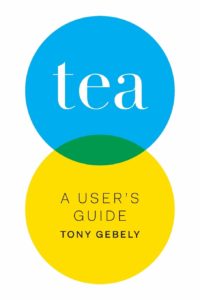 Tea: A User’s Guide
Tea: A User’s Guide
By Tony Gebely
Purchase at World of Tea
Eggs and Toast Media
If you are one of those who load the software and ignore the user’s guide then regret never fully utilizing its features, you need to read this book. Tea is as complex as you make it—many dunk and run, but if you savor the nuances of specialty tea and want to really immerse yourself, this book contains the most thoughtful and detailed insights of any Western author. Eggs and Toast Media, 250 pages, $20 (PDF Download at World of Tea). Also available on Kindle and in print at Amazon.com. LEARN MORE
A User’s Guide to Tea You will Use
Reviewed by Dan Bolton
Start with a bountiful quantity of leaf, and a second steep reveals nuances that delight. And so it is with a second reading of Tony Gebely’s remarkable new book, Tea: A User’s Guide.
As Gebely, 33, explains it: “Multiple steeps allow us to achieve snapshots of the tea as dissolution begins, runs its course, and slowly putters out…. These snapshots accentuate nuances in the tea that may become muffled during longer infusions.”
His brilliant 250-page work distills and organizes hundreds of posts from the award-winning World of Tea blog that established Gebely’s reputation for clarity on a complex topic. The blog has twice been named best blog in the annual World Tea Awards.
Tea contains an estimated 30,000 polyphenolic compounds, writes Gebely in an opening chapter on tea chemistry that introduces the pigments, enzymes, amino acids, carbs, volatiles, and mineral building blocks that make tea such a remarkable beverage.
The body of the book describes 130 classic specialty teas with the precision of a high-level computer scientist. Gebely works as a chief technology and integration officer and has assisted several tea retailers configure web and in-store software. He applies rigorous conformity throughout the book; every tea is photographed (leaves and liquor) in a cup that holds precisely 20 cubic centimeters of water from Clairvic Spring in Volvic, France. The pH-neutral water contains 130 parts per million of total dissolved solids with a mineral content in mg/l of calcium (12), sulfates (9), potassium (6), silica (32), and chlorides (15).

A second read prompted a dozen margin notes underscoring the points he makes about preparation and the insights he offers in the chapter on processing. In his introduction, he establishes that “this book isn’t about all tea. It’s about specialty tea. The goal of this book is to celebrate the diversity of fresh, complex loose-leaf specialty teas.”
Gebely provides the knowledge needed to develop a personal style of tea appreciation, particularly salient in the West, where brewing tea is mainly “dunk and run.” There are few mentions of tea culture in this reference: “Early on while writing this manuscript, I realized that by separating tea culture from objective tea study, we are left with a much better framework for tea education,” he writes.
What Western tea drinkers need is to hone their skills in selecting and preparing fine tea. Gebely’s simple steeping chart is a starting point. Instead of the typical manufacturer’s temp and timer icons, Gebely introduces a grid.

“Your ideal parameters may vary, especially the steeping time,” he writes, explaining the relationship between dosages, time, and temperature.
This user’s guide is just that, explaining tea chemistry and processing and presenting historical background (without mythology) covering a most intriguing collection of teas. He offers a very useful explanation for establishing “altered tea” as the seventh main category.
The majority of teas sold in the United States are altered in some way, observes Gebely. Some of the most exquisite specialty teas (think jasmine scented) are altered. The category embraces flavored and scented teas, blends that feature inclusions such as fruit, nuts, and florals along with breakfast blends of pure teas that deliver consistency in flavor despite the annual variance of the harvest. Herein lies masala chai and Japanese genmaicha, a mix of sencha and roasted rice and beloved Earl Grey, a tea flavored with oil of bergamot that accounts for a quarter of U.S. tea consumed by volume.
Gebely’s diverse tea descriptions demonstrate the 35 nations that grow tea and offer a style for every taste. However, more critical, in his view, is giving readers the confidence to brew any tea they might want to try.
In The Kinetics of Steeping section, some 182 pages in, Gebely announces “the most important part… the entire reason for your tea journey.
“Steeping is the final step in the lives of tea leaves. And in their final act, they slowly unfold and unravel, creating a beverage that tells the story of where they came from. Every time we drink liquor from the steeped leaves, it tell us what the weather was like before they were plucked and how they were handled, processed, and stored before they reached your cup,” writes Gebely.
It is these chapters on preparation, including tea evaluation, and storage that the margin notes in your edition will likely equal or even exceed the margin notes in mine.


